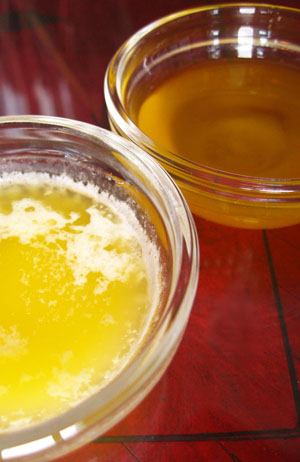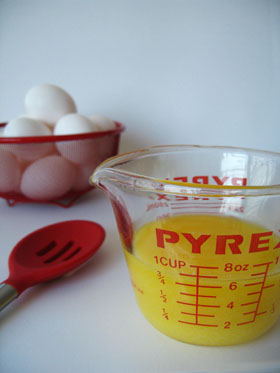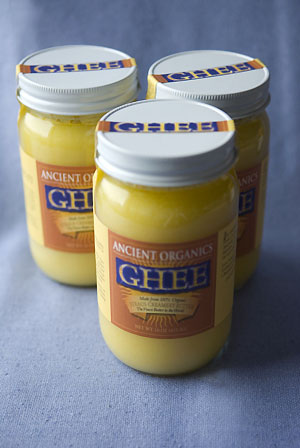 |

| |

In the making of ghee, butter (at left) is simmered so that the milk solids rise to the surface and fall to the bottom. The surface solids are skimmed and the butterfat is strained from the bottom solids to become the clear ghee at right. Photo by Emily Chang | THE NIBBLE. |
| WHAT IT IS: Ghee, a type of clarified butter. |
| WHY IT’S DIFFERENT: It’s made from 100% organic Straus Creamery butter, by an American Ayurvedic physician. |
WHY WE LOVE IT: Great taste, better for you (no lactose), easier to cook with, long shelf life with no refrigeration (you never run out of butter). |
| WHERE TO BUY IT: AncientOrganics.com and specialty, natural and health food stores nationwide. |
| FOOD PRIZES! ENTER THE GOURMET GIVEAWAY: This week, 12 winners will each receive a 12-pack of True Brew Organic Iced Tea. One winner will receive a Smucker’s Healthy Picnic Basket. Gourmet Giveaway details. |
|
|
 |

Ancient Organics Ghee
Page 3: How To Make Ghee
This is Page 3 of a three-page article. Click on the black links below to visit other pages.
INDEX OF REVIEW
MORE TO DISCOVER
|
The Difference Between Ghee & Butter
Ghee is heated at a higher temperature and for a longer period of time than clarified butter. The resulting product is thoroughly cleansed of milk proteins, and slightly thicker than clarified butter; it also has a flavor that is richer and more complex.
Both ghee and clarified butter begin by melting unsalted butter (some home cooks prefer lightly salted butter) in a pot, then slowly simmering it until the milk solids separate and turn brown. (At this stage it is similar to the butter known as beurre noisette, butter cooked over low heat until it turns the golden brown color of hazelnuts. It is used to sauté and sauce meat, poultry, fish and fruit; and also serves as a sauce for pasta and vegetables. See our Butter Glossary for more information)
At this point, some milk solids float to the surface and are skimmed off; the remainder sink to the bottom and are left behind when the butterfat is poured off as clarified butter. Ghee, however, continues its evolution, slowly simmered until all of the water in the original butter has been evaporated. (Clarifying butter takes about 10 minutes; making ghee can take from 15 to 18 minutes.)
|
|

Ghee at room temperature (when melted, it becomes the clear golden liquid in the photo above). Use it instead of butter to cook eggs—you need far less for the same buttery taste. Photo by Emily Chang | THE NIBBLE.
|
Ghee is then strained. The remaining liquid is a pure fat with a lovely golden color. To the uneducated eye, melted ghee could be a rich culinary oil (see the photo at the top of the page).
Because ghee can be costly to buy yet easy to make, here’s a recipe. You can make ghee in fewer than 20 minutes.
How To Make Ghee: A Recipe
Butter renders down to half the amount of ghee. Decide how much ghee you want to make.
- Melt unsalted butter in a medium-size, heavy-bottom saucepan on medium heat until it reaches a slow, rolling boil and starts to bubble and foam. Watch it carefully, as ghee can burn.
- As soon as the butter bubbles, reduce the heat to medium-low and cook it until it turns a clear golden color and a sudsy foam of milk solids forms on top. You know that it’s done when the sputtering/crackling sound stops. You’ll also see clear butterfat underneath the foam.
- Remove the pot from the heat. Carefully skim off the foam from the surface and discard. Repeat the heating process several times to allow more solids to rise; skim. The amount of solids will diminish substantially each time.
- Turn off the heat and let the contents rest. A skin-like film will form; remove and discard. What remains is the ghee plus the heavier milk solids which have sunk to the bottom.
- Cool moderately (do not allow to solidify) and strain the ghee into a clean, dry glass jar (jelly or mayonnaise jars with airtight lids are good), using a cheesecloth or a very fine mesh strainer. Discard the solids.
- Store at room temperature (refrigeration optional), but keep in a dry place away from moisture. Keep the ghee “dry”—never scoop with a damp or wet spoon.
Fresh ghee will improve with age. But you’ll find it so useful that it may not be around long enough for you to find out.
— Karen Hochman
Ancient Organics Ghee
Ghee Made From Organic-Certified Milk
- 16-Ounce Jar (453.59g)
$18.75
- 32-Ounce Jar (907.18g)
$32.50
Purchase online* at AncientOrganics.com
Telephone 1.415.868.9890
*Prices and product availability are verified at publication but are subject to change. Shipping is additional. These items are offered by a third party and THE NIBBLE has no relationship with them. Purchase information is provided as a reader convenience.
Go To The Article Index Above |

Photo by Corey Lugg | THE NIBBLE. |
Do you have friends who would enjoy THE NIBBLE?
Click here to send them an invitation to sign up for their own copy. |
© Copyright 2004-2025 Lifestyle Direct, Inc. All rights
reserved. All information contained herein is subject to change at any time
without notice. All details must be directly confirmed with manufacturers, service
establishments and other third parties. The material in this e-zine may not
be reproduced, distributed, transmitted, cached, or otherwise used, except with
the prior written permission of Lifestyle Direct, Inc.
|
|

|
 |









